Intel reveals 22 more 12th-gen 'Alder Lake' CPUs, some without E-cores

 Image: Intel
Image: IntelWere you hoping that Intel would sell the new 12th-gen Core “Alder Lake” desktop chips with only performance cores? If so, you’ve got your wish… sort of.
At CES 2022, Intel answered some of the questions surrounding its “Alder Lake” 12th-gen desktop Core chips, unveiling the remaining 22 processors, the supporting chipsets, and even the coolers that will chill the chips. Intel also unexpectedly launched the 12th-gen “KS” processor, which will run at up to 5.5 GHz.
Intel may have launched its 12th-gen desktop Core CPUs in October, but it did so with just a minimal offering, only three processors or six if you count additional “F” versions with a disabled integrated GPU. On Tuesday, Intel added thirteen mainstream 12th-gen Core processors at CES 2022, with 65W offerings ranging from a Core i9 down to a Celeron processor plus an additional nine “T”-series processors optimized for low-power 35W systems.
Intel launched the new desktop processors at CES 2021 as it readied its mobile 12th-gen Core (Alder Lake) chips alongside it, preparing the market for an Alder Lake attack in both the desktop and notebook space. Tuesday’s announcement provided a bit more context for enthusiasts and DIY consumers interested in researching motherboards and prepping their own systems. Remember, as Intel explained this summer, Alder Lake uses an LGA 1700 socket that’s incompatible with older motherboards.
The CPU manufacturer made the announcements at CES 2022, where the company announced new 12th-gen “Alder Lake” CPUs for laptops, plus an expansion of its Evo platform. Intel also said that it has begun shipping its Arc GPUs, too.
Intel’s new desktop Alder Lake processors
Intel revealed its new Alder Lake desktop processors in a briefing with reporters, hosted by Mandy Mock, vice president of Intel’s Client Computing Group and general manager of its desktop business. They’ll be used for a variety of applications, ranging from mainstream desktops to more specialized devices for retail, manufacturing, and more.
If you look closely at the charts below, you can see that many of the processors such as the Core i5-12600 don’t offer efficiency cores. While they may be 12th-gen Core chips, they don’t offer the performance hybrid architecture that defines Alder Lake. All of the Core i7 and Core i9 chips do, however. This supports Intel’s earlier claims that the efficiency cores are as powerful as its older 8th-gen chips and can be used as “performance” cores when needed.
It sounds like including or excluding efficiency cores will be an option Intel will select when necessary. “We focus on giving the most performance at the top of the SKU stack and then offer options that give the value that end users really want all the way down through this stack,” Mock said in a briefing with reporters. “So, we have a variety of configurations that include different numbers of cores as well as different features from the top to the bottom.”
Intel waited until its keynote address to announce something that doesn’t appear in the slides below: the 12th-gen Core “KS” processor, which Intel Client Computing Group executive vice president Greg Bryant said would ship by the end of the first quarter of 2022. It will run at up to 5.5GHz, running at turbo mode in both single-core and multicore mode. Intel showed the processor running Hitman 3, with all cores above 5.2GHz.
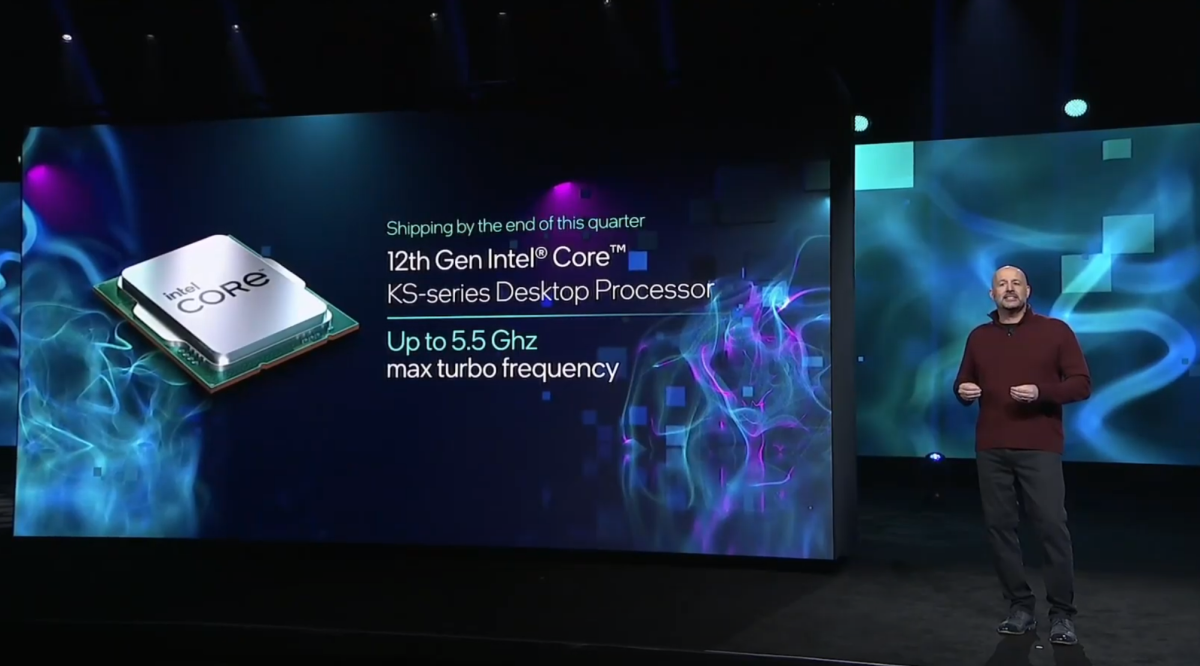
Intel / YouTube
Intel / YouTube
Intel / YouTube
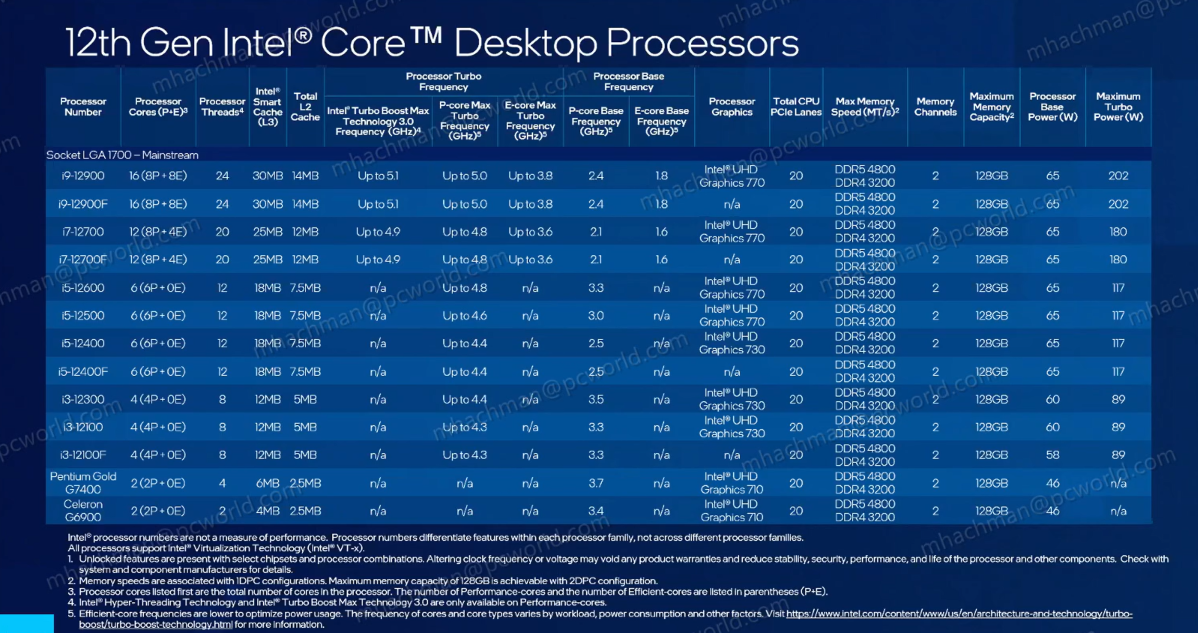
Intel
Intel
Intel
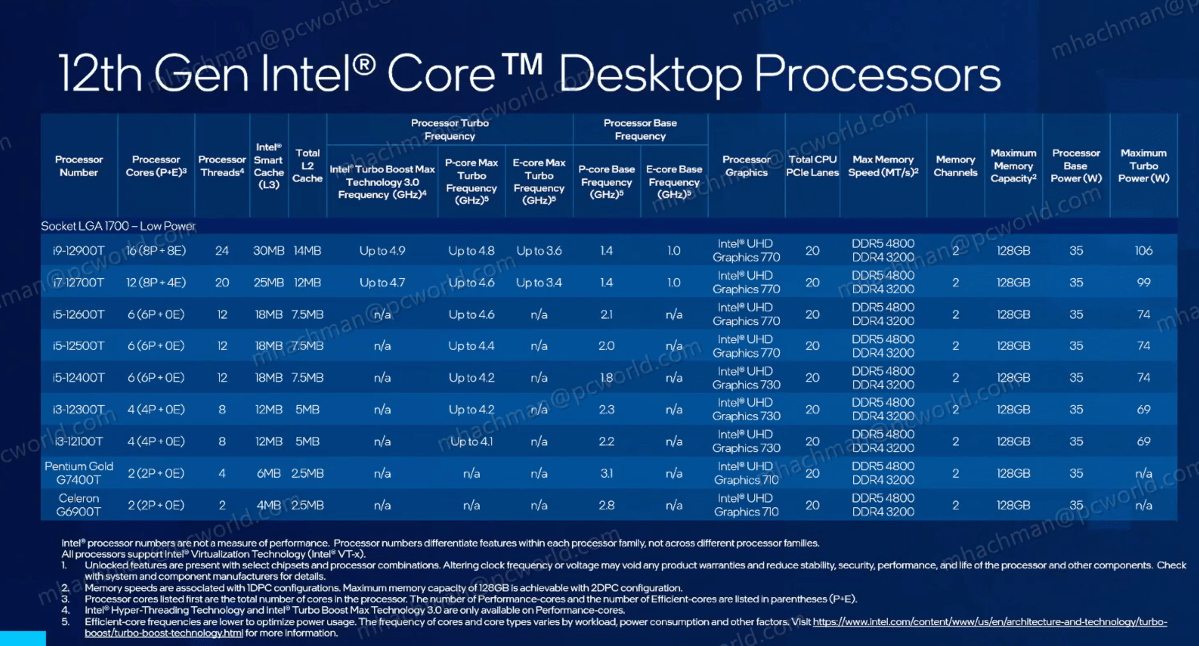
Intel
Intel
Intel
Mock explained that Intel’s new Alder Lake socket prompted the company to reinvest in new cooling solutions, too. The older coolers are incompatible with the new socket. According to Intel, the Laminar RH1 cooler (with RGB lighting as well as 2.6 dBA near-silent performance) was designed for the Core i9. Intel believes that the Core i7, i5, and i3 will be paired with the Laminar RM1 cooler (3.9 dBA). The RS1, meanwhile, will be used with the Pentium Gold and Celeron chips at the bottom of the processor lineup. Intel didn’t reveal any standalone pricing.
Though the turbo power of processors like the Core i9 will soar to over 200 watts, PCWorld testing proves that Alder Lake isn’t the power hog these numbers imply.
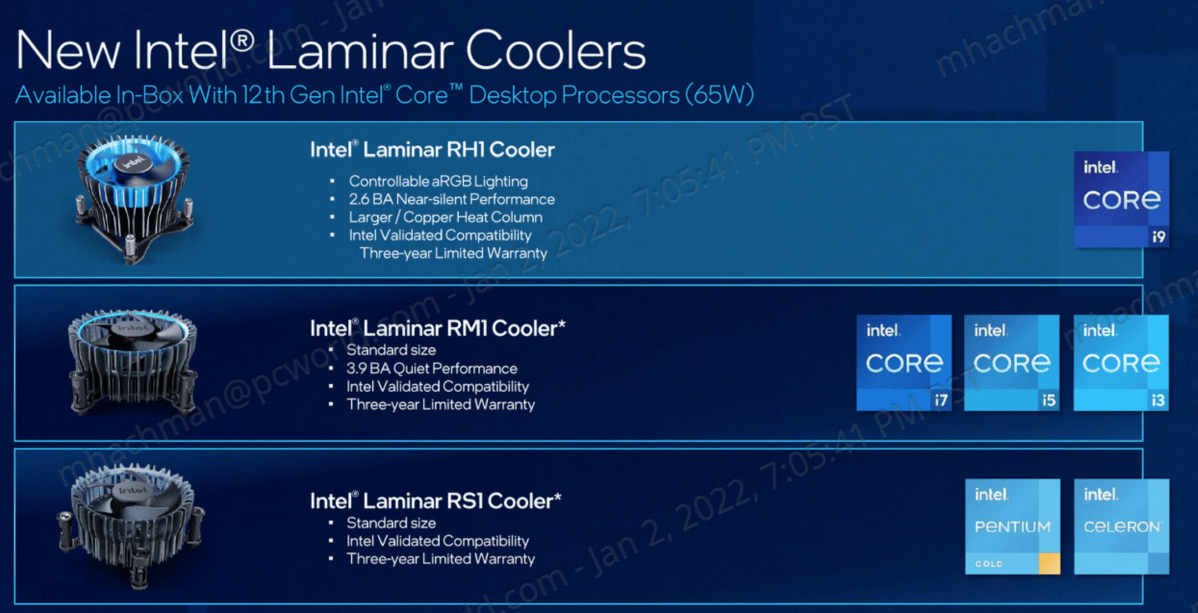
Intel
Intel
Intel
Although Intel provided performance data at its Alder Lake launch in October, Intel added some more mainstream comparisons regarding the performance of the Core i9-12900 as well as the presumably more affordable Core i5-12600. Intel did not release any consumer prices of its new chips. “The recommended customer price (RCP), which is only guidance for direct Intel customers (not consumers), for the 12th Gen Intel® Core™ desktop processors starts at $42 to $489,” an Intel representative said via email.
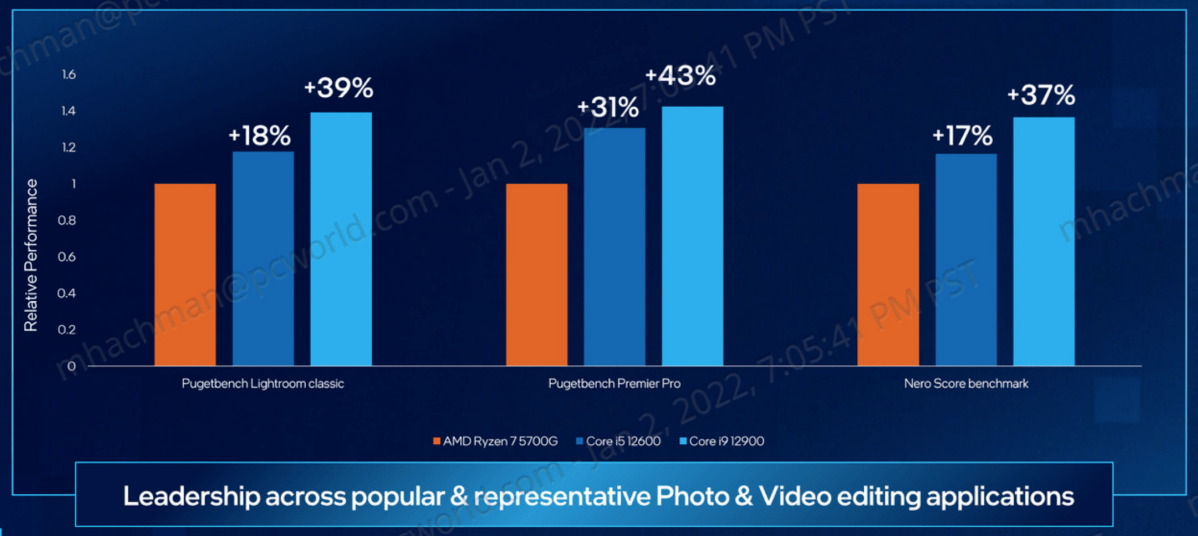
Intel
Intel
Intel
Guy Therien, an Intel fellow, also offered an update on the DRM issue that struck the first Intel Alder Lake launch. 91 games were impacted by their DRM’s inability to interact properly with the mix of performance and efficiency cores. Today, Intel has fixes for 89 of those titles: 54 via patches and 35 more through working with Microsoft to get fixes into Windows operating system for the remaining titles, he said.
Here are the new Alder Lake chipsets
Intel also provided all of the new chipset configurations that will be available as part of motherboards accompanying the new Alder Lake processors. Intel expects over 200 motherboards in all, produced by over 140 companies across 30 countries, Mock said. In October, Intel launched Alder Lake alongside the Z690 chipset, the only 12th-gen Core chipset which offers overclocking of both the performance and efficiency cores.
In addition to the Z690, Intel has now launched the H670, B660, and H610 chipsets, each with slightly differing feature sets. For example, the H670 and B660 appear very similar, but a reduced number of DMI 4.0 lanes between the processor and chipset will result in fewer I/O expansion options, too.

Intel
Intel
Intel
Finally, Intel’s Kate Porter, senior director of segmentation and scale for Business Client Platforms, shared what’s in store for Intel’s business platform, vPro. Intel plans to break down its vPro branding into four different sub-brands: Intel vPro Enterprise (the full-featured platform with top-tier manageability, security, and stability), vPro Essentials (for small businesses), vPro Enterprise for Chromebooks (to address the small but growing niche of enterprise around Chromebooks), and “Intel vPro, an Intel Evo Design” — basically, a business notebook designed around Intel’s premium Evo brand.
This story was updated at 10:43 AM with additional details.
Author: Mark Hachman, Senior Editor

As PCWorld’s senior editor, Mark focuses on Microsoft news and chip technology, among other beats. He has formerly written for PCMag, BYTE, Slashdot, eWEEK, and ReadWrite.
Recent stories by Mark Hachman:
Acer Predator Orion 3000 review: Compact gaming PC powerAMD gains big in desktop CPUs versus Intel in first quarter 2024No, Intel isn’t recommending baseline power profiles to fix crashing CPUs






